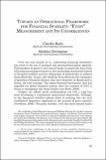| dc.contributor.author | Borio, Claudio | |
| dc.contributor.author | Drehemann, Mathias | |
| dc.date.accessioned | 2019-11-01T00:04:51Z | |
| dc.date.available | 2019-11-01T00:04:51Z | |
| dc.date.issued | 2010 | |
| dc.identifier.isbn | 978-956-7421-34-3 | |
| dc.identifier.uri | https://hdl.handle.net/20.500.12580/3759 | |
| dc.description | Over the last decade or so, addressing financial instability ¿has risen to the top of national and international policy agendas. Policymakers in general and central banks in particular have been allocating increasing resources to the monitoring of potential threats to financial stability and the elaboration of frameworks to address them effectively. In part, this trend has been driven by the emergence of episodes of financial distress that have derailed, or threatened to derail, the real economy. The major financial earthquake that has engulfed the global financial system since the summer of 2007 is bound to strengthen this trend further (see Borio, 2008). | |
| dc.format | .pdf | |
| dc.format.extent | Sección o Parte de un Documento | |
| dc.format.medium | p. 63-123 | |
| dc.language.iso | eng | |
| dc.publisher | Banco Central de Chile | |
| dc.relation.ispartof | Series on Central Banking, Analysis, and Economic Policies, no. 15 | |
| dc.rights | Attribution-NonCommercial-NoDerivs 3.0 Chile | * |
| dc.rights.uri | http://creativecommons.org/licenses/by-nc-nd/3.0/cl/ | * |
| dc.subject | ESTABILIDAD ECONÓMICA | es_ES |
| dc.subject | BANCOS CENTRALES | es_ES |
| dc.title | Toward an operational framework for financial stability: 'fuzzy' measurement and its consequences | |
| dc.type.doc | Artículo | |
| dc.file.name | BCCh-sbc-v15-p063_123 | |


